Jane emailed me a couple weeks ago with a question. She’s been a reader here on Needle ‘n Thread since 2007, which is a pretty long time!
Her question:
Mary, you review a lot of interesting needlework tools, but when it comes down to it, what do you use every day? I imagine most of the tools you review (like the aficot or the stumpwork sticks you showed us) only come out occasionally.
What I want to know is what are the tools and accessories and other things that surround you all the time when you’re doing embroidery – not the expensive specialty tools that only do one job, but the things you find yourself working with every day, that you couldn’t work without?
I pondered this for a bit. It’s a fair question! And so, at the end of a work session one day, I set about to show her the answer, by gathering all the tools – and other things – that I use in my workroom on almost a daily basis.
Here’s my answer:
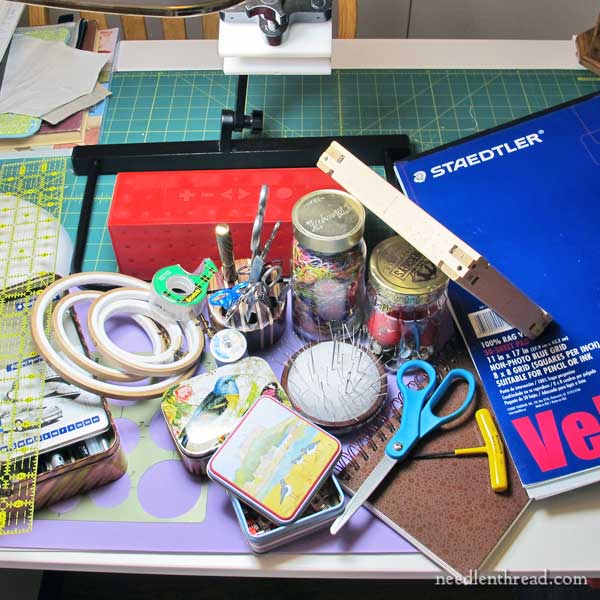
My collection of embroidery “tools” looks kind of jumbled and messy, and it might even look like a lot of stuff, but in reality, there’s not a whole lot there.
I didn’t include fabric or threads, but just the tools and accessories I work with pretty much every day at some point, that make the stitching side of my life easier, more pleasant, more manageable, or just plain doable.
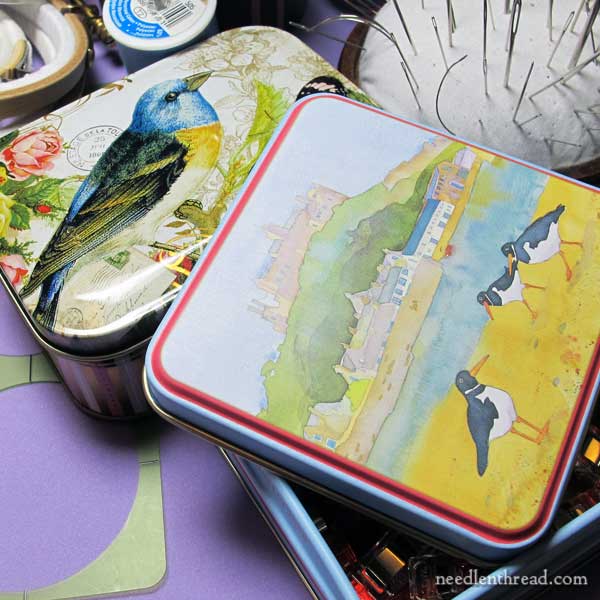
I have several small tins on my work table, and they contain wonder clips, sewing pins, packs of extra needles, and push pins.
Every day, I access these tins, whether it’s for pins to pin a pattern in place, or for just the right sized milliner needle that isn’t in my pincushion, or for a wonder clip or two to hold a fold closed on a piece of fabric, or push pins for blocking finished projects or for pinning up a note or reminder.
In the lower left of the photo, you can see a green circle template. I use this a lot, so I keep it easily accessible; otherwise, I’d never be able to find it.
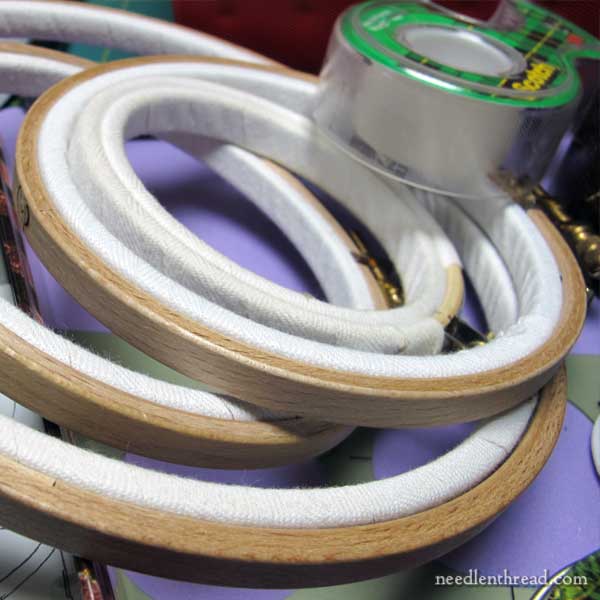
I use different sized hoops repeatedly – specifically, six inch, four inch, and three inch hoops, which all have at least the inner ring bound.
These are the embroidery hoops I use, and I’ve been using them for years and years. They’re essential for me, not just for projects, but for tutorials. Practically every stitch tutorial you see on Needle ‘n Thread involves one of these hoops.
A roll of Scotch tape is always within easy reach, too. I use Scotch tape for lots of stuff, from taping patterns in place, to removing fuzzies from fabric.
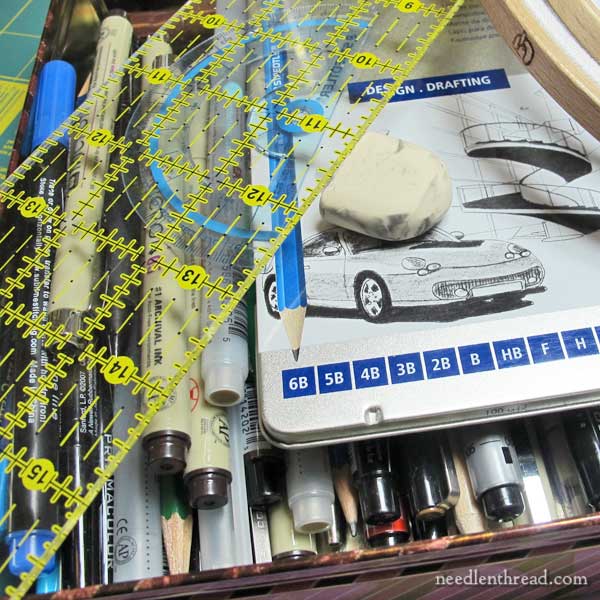
I have a tin of pens and pencils, erasers, and small rulers that I access daily, whether it’s for pencils for sketching, pens for tracing patterns, or just general doodling or list-making or whatnot.
An 18″ quilter’s ruler is also always on hand. I’m always measuring, and I like see-through rulers marked in 1/8″ intervals. They’re great for working out evenly spaced straight lines on paper or fabric.
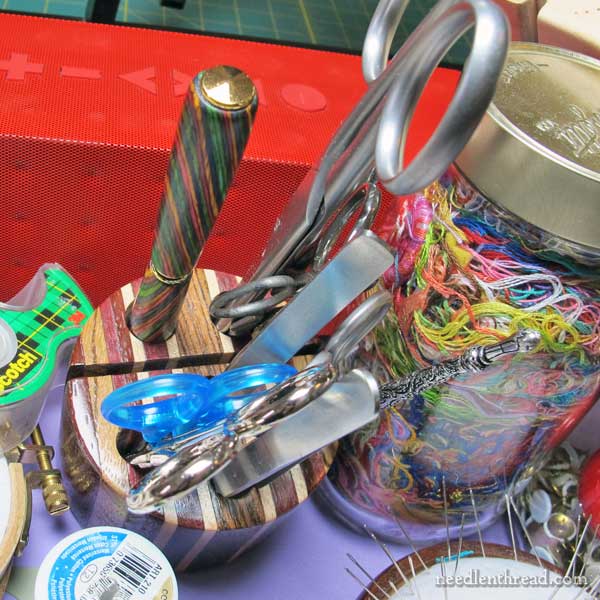
Scissors. I use lots of scissors. I use good scissors for stitching (specifically, the ones I use most for embroidery are these Premax ring lock scissors and my Dovo scissors).
I also use fabric shears all the time. Cutting a large piece of fabric with a tiny pair of embroidery scissors is a most uncomfortable task, so having a good pair of fabric sheers is pretty important to me.
I use my laying tool often. Maybe not every single day, but pretty close. (It’s the tool encased in striped wood. Here’s the information on these tools and where they come from.)
Also tucked in the tool caddy (which you can read about here and which is a very nice accessory that’s always within easy reach) are several pairs of tweezers. These are used often, usually for picking out mistakes!
In the foreground of the photo, you can see a spool of thread. I always have a spool of blue sewing thread on hand, for marking visible lines on fabric with basting stitches.
In the background of the photo, the red thing is my bluetooth speaker, over which I listen to music or audio books while I work.
The jar on the right is my orts jar, where I store thread scraps. Next to that (you can only see part of it) is a jar with thumb tacks and my e-z tack-it tools, that I use for stretcher bar frames.
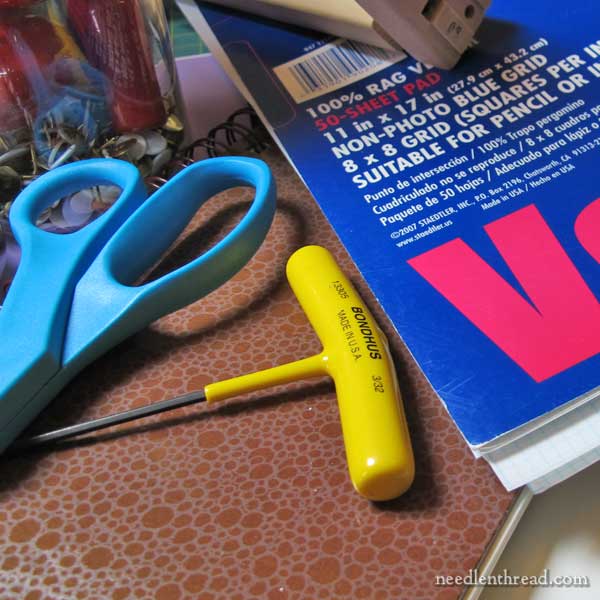
I use Evertite frames all the time, so the yellow T-tool here is a daily friend.
Paper scissors – they’re always very close on hand, so that I’m not tempted to cut paper with my sewing or embroidery scissors.
A pad of gridded vellum and a sketch book take part in my daily routine, too.
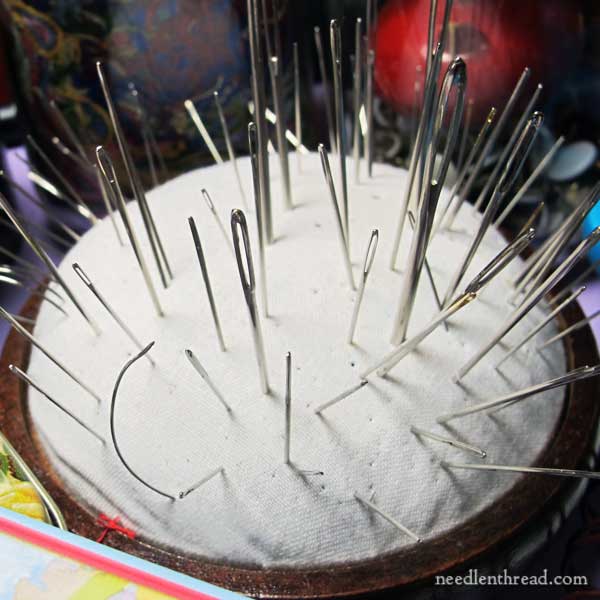
I use this pincushion basefrom Lorna Bateman all the time, and I use the needles in it pretty frequently.
I haven’t had a chance to embroider the pincushion yet, so the base is naked right now. Some day, I’ll dress it up!
Outside the photos
There are a few things you can’t see in the photos above:
Stitching stands – I use them interchangeably, depending on the project. For small projects, though, I most frequently use the Needlework System 4 table stand that you can see in the first photo.
Lights – I use these BlueMax lights daily.
Camera – which, second to needles and scissors, is one of my most frequently used tools.
As far as daily tools go, that’s pretty much it – nothing too exceptional!
But while I don’t use specialty tools every day, when a certain type of job needs to be done, it’s always nice to have the right tool for the job.
What are your daily tools?
What tools do you find yourself using on a daily basis? Do you have any pet tools that never leave your side? The rest of us would love to hear about them, and sharing what you use may be very helpful indeed for other stitchers looking for tools that can help make their stitching time more pleasurable.
Feel free to chime in below and tell us about your most frequently used needlework tools!







Hi – just wanted to say i love your website, I can already tell my next few weeks will be spent trawling the information you’ve posted so I’m pretty happy!! I’m relatively new to embroidery so it’s great to find such a treasure trove of information!
I was hoping you could answer a question about an old post you made though. I came to your website while researching embroidery trestles, and ended up reading the two posts you have about a custom made trestle your friends dad made for you. It was posted back in 2009, so I’m guessing it might have fizzled out for some reason, but I wanted to check and see if they are for sale somewhere? I have been trying so hard to come up with a trestle, and the only one I can seem to find here in England costs £520 (about $800), which is way outside my wee budget 🙂
Anyway, once again, I love your website and you have such a nice writing style. I hope to hear back. x
Hi, Samantha – the only places I can recommend finding trestles in the UK are the RSN and Sophie Long’s website. Here in the U.S., the only place I know of where they are available is through the RSN in San Francisco. Not sure you’d get a good deal, if you had to pay for shipping!
I think you’ll be able to find quite affordable trestles in stores specialized into home renovation, as carpenters’ tools for the ordinary wooden one or table legs. I can’t give you any name as I live in France, but that’s what many embroiderers do here (even my Luneville embroidery teacher) !
Some can be folded and some are even adjustable in height. You can have a look at Ikea website to give you an idea… Prices are between $15 and $40 but I think you can even find cheaper ones !
You could try IKEA. Some of my students don’t like the price tag on the RSN wooden tressels either (however, I think they are the best solution), they use the IKEA ones. Here is a link to the German page: http://www.ikea.com/de/de/catalog/products/80150095/. Good luck!
On trestles, I admit to another low cost hardware store solution. I use some inexpensive folding steel sawhorses, tossing towels over their tops to protect the work. Mine are like these. http://t.homedepot.com/p/HDX-1-Compartment-Folding-Steel-Sawhorse-SH106/202528731/
Ugly, but affordable and easy to stow when not in use.
Thanks for all the suggestions!!
I have no idea why trestles are so expensive in England – even the ones for construction-type work are pretty pricey (carvers sell them for £50 per trestle) – or cheap but very far from where I live. I wish we had a Homedepo like in the US, that one is the only one really in my price range so far. Anyway – I’ve put the Ikea table trestles on my “when I have enough money” list, but I think I’ll take a stab at building something for the job for until then. I have random timber around so it should be possible… It’ll probably be hideous, but hopefully it’ll do the trick!
Thanks again for the advice. x 🙂
Another solution from the hardware store that may be available where you are might be getting just the sawhorse/trestle clamps or hinges and using your own lengths of lumber. In the US they are called “Saw Horse Brackets.”
One advantage to creating your own trestle this way is that you can create a custom height or width, best suited to your favorite work environment.
The brackets look like this. You’d need four for an effective work set-up (two per trestle). In the US they can be had for as little as $7.00 each:
http://www.cassvalleyent.org/wp-content/uploads/2011/10/Saw-Horse-Brackets-soft1.jpg
Hope these are available where you are.
I am surprised that you did not have a single thimble on your table. While I have the usual pile of scissors, hoops and needles, I rarely hand stitch without my thimble. I use the inexpensive Dritz metal ones since I carry them with me and tend to lose them or give them away. I do have a small collection of them from leather, plastic and ceramics, but daily I use the old fashioned metal one, just like Grandma.
Hi, Debbie! The reason you don’t see a thimble is just because I don’t normally use one. The only time I use a thimble is when I’m working on particularly quarrelsome fabric or layers of fabric, where the stitching is difficult. That doesn’t happen too often!
I’m another thimble user. I use Colonial’s stick on leather thimble pads. I would be lost without them.
Not a fan of thimbles either. I think you loose too much control over your stitching. Sometimes, however, they can’t be avoided…
I don’t use a thimble for embroidery. I rarely use one for sewing unless it absolutely necessary. I have very small fingers and have trouble keeping the thimbles on my fingers – even the size 4 thimbles fall off lately. When I use a thimble I use an open ended one because if the thimble had to sit on the end of my fingernail, I would need even a smaller one to try to keep it on my finger.
Learning the language and skill of stitching requires repetition and review. My iPad is a tool I use every time I sit down to stitch at this time. Since I am a beginner my tools are very simple. Once I have my design on fabric, it’s my needle, thread, scissor and iPad. Have a great day everyone.
Mauri in Arizona
Our sets are much aligned, but I’d elaborate on the tweezers.
I keep a pair of precision smooth grip needle nose tweezers in my kit. These are not the ones made for cosmetic use – these are intended for use in precision electronics manufacture. While it’s not necessary to spend a fortune for the special coated, non-magnetic ones, plunking down a couple of dollars extra to get the pointy end and firm grip engagement is worth every penny.
I use mine to remove thread snippets when ripping back, as a laying tool, and as an aid in withdrawn or drawn thread work. Sometimes the best tools can be found in non-traditional places, like the hardware store. 🙂
A couple of my tools I also purchased at an electronics store, a small pair of pliers and a small, short screwdriver being the two I can think of off the top of my head. 🙂
I just had to add what I consider a most valuable tool for me. Painters tape. Unlike scotch tape you can pull it off fabric or paper and reposition a pattern or what else you need that must not move over and over again. It never lets me down. But my very very best tool is you Mary Corbet. Without all your tutorials and hints of the day I would not even know how to embroider. I am in your debt.
Donna W. Houston Texas
Interesting post! My daily tools include my Ott light (I use it for everything, not just stitching!), a variety of embroidery scissors (which set I use kind of depends on what kind of needlework I’m doing), and lately, my Elan lap stand.
Everything else (laying tool, hoops, stretcher bars, etc) are project dependent. Sometimes I need them, sometimes I don’t.
The “designer tool caddy” from Nordic Needle is my new “best tool”. Holds 2 pair of scissors, needles, laying tool, small ort container, small ruler, and threads(which I keep in a small plastic bag) and lays flat. Love it as I can see and access everything easily, yet it is hard sided and closes to a nice box that I find acceptable to leave sitting out on the table in our family room.
A needle threader. A magnet. Needle minder (I think that is what it’s called — the magnet on your shirt to park your needle). Plastic baggies. Sulky Sliver thread for line basting. Air / water soluble pens. Magnifier.
Mary, just finished a big project so my tools are in disarray but since I go to several stitching groups I keep the essentials in two plastic food storage boxes, quite small. One is for surface embroidery and has small scissors, needles stuck in a fabric swatch, tweezers, needle threaders, thimbles. I have a second one for canvas work with tapestry needles sorted into those magnetized needle keepers, scissors, laying tool, tweezers. It isn’t perfect to I usually carry both little kits. Perfect would be another laying tool and a more orderly mind. I use embroidery hoops and frames. I lust for a System 4 floor stand especially for larger framed projects. Since I also sew and quilt I have a whole separate area and keep my shears carefully tucked away and a pair of fabric scissors close to the machine. Thanks for the tip about using tape to remove fuzz, I knew that and had forgotten it. Thanks for all the info. The recent column on filling stitches was absolutely OUTSTANDING!
Dear Mary
I’m back I had a great time in Liverpool managed for a very short time to view the embroidery gallery, but did not have time to linger which was a shame. Apart from the normal needle, thread and fabric, my everyday go to equipment are my sew mate scissors which I love because they are small and great for taking out stitches, pins are at hand in my desk in a box and I have a small divider on my desk with scissors, wonder clips, tweezers, laying tool, my newly acquired aficot, basting thread, micro pens are kept in my draw with rulers, sellotape and various other items and of course my computer for research. I use my necessaries floor stand daily and for lighting I use the dublin craftlite magnifier. Thanks for showing us your everyday embroidery equipment and you use them.
Regards Anita Simmance
You should do an article about tools in general. You probably have a smokin’ great list since you likely do more varieties of embroidery than the rest of us. I do not have a craft room or specific space, so I have a box that contains my projects and tools. I can just pick it up and go to the couch or the patio or wherever. I have over 40 tools in my box, but I do not use them all regularly, I just have no space to stash them in one location. Ultimately, that is why I purchased the box. So I guess, my craft box/basket is the first tool on my daily use list. I also have my snips and several thimbles (depending on which finger is being assaulted) and a thin (about 2/3rds of an inch wide) 6 inch long metal ruler. The ruler my pop gave me, he used to do drafting (now on computer) so now I use it. I also have a small metal breath-mints tin for my ORTS, and a floppy refrigerator magnet to collect needles I may have dropped. I have a large strawberry emery and a pincushion. The pincushion is a terra-cotta saucer with a small UFO shaped pillow glued into it. Just above the rim of the saucer, I have a row of pins so that if I need one, I can grab one. I also have a short small screwdriver so that I can tighten the closures on my hoops. I have a pair of tweezers in case I need to undo a stitch or two, and a few needles. I also have a needle threader for metallic or rayon threads which I only use now and then, but it is still in the daily use project box. I keep my current project floss in a floss box, and I also use that box every day. 🙂 I also have a second metal breath-mints tin that I keep an alcohol wipe and a few spot shaped bandages in for thimble-less accidents. I also have a pencil and a teensy pad of sticky-notes.
I started in cross-stitching, so my daily tools are: hoops, scissors, an ort jar, needles. The needles have the most variety, as I like to use beads and embellishments when I work.
Currently, I’m working on an embroidery piece large enough to require a lap frame instead of a hand-held hoop, so in addition to the tacks needed to hold the fabric on the frame, I’m using a regular clamp from the hardware store to hold the frame on a small table, as I found it easier to stitch that way.
This is especially true because I have a great dane that likes to help me stitch… except when she’s ‘digging for gold’ on the couch. I was doing a woven stitch last night for the first time ever, and the dog decided to do the digging thing right at that moment. It was not helpful, LOL.
-Monika in Mobile
Hello Mary, love your daily blog, the only embroidery I do are labels for my sons quilts and way back when embroidery for denim shirts, remember those. Could you tell us what a laying tool is, I keep trying to figure it out. Also you have no need for a small six inch ruler and what about a thimble, and I always need wax for my thread. Look forward to your post every day.
I like to use beeswax to condition my hand-sewing thread, and I use “Thread Heaven” thread conditioner for cotton floss and for silk thread for blackwork.
I’d be interested in other’s views on thread conditioners for embroidery.
For a ruler, I like to keep a small 6″ one as well, and I really like the clear plastic ones with the red grid. They aren’t as thick as the quilt rulers, so it is easier to be accurate with them.
When I’m at the designing stage, then I am working at home with my Pura worklight, boxes and bags of fabric, threads, graph paper and drawing materials, reference books, etc, etc, all to hand (if I can actually find what I want in the chaos). But all that kit is not needed for my everyday carry-around projects, once I’ve got past the design stage.
Looking at my faithful stationery-shop zipper-wallet (it’s past time I got a new one, as this one is held together mainly by sticky tape now), there’s fabric and thread, the chart and/or notes I’m using, magnifying spectacles, my 2nd-best stork scissors, a needle-threader (mainly used for dealing with thread ends), a little bag for short but usable lengths of threads, and another for pure orts and scrap. What else is in there depends on the thread and technique I’m using. Currently it’s silk thread and each reel is in a little ziploc bag to keep it clean and tidy, and there’s a little lump of beeswax in its box, too. I’m not using a hoop for this piece. There’s a scrap of fabric to hold a few spare needles. (Nothing more annoying than losing my needle when I’m out and about.) The scrap gets used for trying things out, too, if an idea strikes when I’m away from home. The camera is in frequent use if I want to blog about a work in progress, but that’s not every day. Perhaps I should add the computer to the list, though I don’t carry it about with me. That’s busy on embroidery-related topics just about every day – including getting my daily fix of Needle’n’Thread, of course.
Hello Mary
The gadget I can’t do without is my MagEyes magnifier. I mislaid it recently and couldn’t do one single stitch until I had replaced it. I got it at mageyes.com
I use the strongest lens and find it completely comfortable to wear.
Wonderful column, Mary. I will be saving it as I work my way up the embroidery chain, so to speak…. Now, I have even a harder question, so take your time. I read everything you write, so I won’t miss it!
Ready? What are the essential threads you use on a regular basis? What silks and what cottons are essential? What are your favorite brands? You can play with this question– pretend you have only $100 to spend on getting started on your embroidery thread stash, what would you buy?
Thank you for all your help. Ginny Hoffman, Carbondale, il
Roaring laugther! My tools are pretty much the same. And we even share the Lorna Bateman ‘raw’ glorious pin cushion wooden base… So, so sorry Lorna! Ever since I bought it years ago, I am thinking of turning it into an even more wonderful creation. Alas. Instead, I spent three days at a tambour work course with the lovely Elisabeth Roulleau from Lyon. If you ever get a change to have her as a teacher, grab it with both hands! She is wonderful. And she travels the world, so you have a good change of encountering her.
Jessica, I envy you that class. Mary mentioned a book which I managed to find called Le Point de Beauvais which I have enjoyed very much. I hope to learn tambour work in the near future. My local stitching friends call it Russian punch needle, I have no idea why. Would you know? It seems to be exactly the same but is there a some subtle difference? Mary? Jessica? Best, Charlotte
Russian punch needle involves creating dense loops on the fabric, whereas tambour embroidery is predominantly chain stitch, although there are some other stitches that can be worked with a tambour hook, but they’re all based on chain stitches. The chain stitch in tambour work is worked from the front. With punch needle, the stitching is done with the back of the work up, and the dense loops form on the other side. Punch needle doesn’t involve the wrapping technique necessary for tambour work, where you wrap the thread around the hook and turn the hook before pulling through. Punch needle is done essentially by dragging the needle forward, pushing or punching it through the cloth, lifting out, and dragging forward again. You don’t manipulate the working thread at all – the thread feeds through the needle. So they are really entirely different techniques.
I have been saving the strawberry transparent plastic containers for my thread spools, one for each color, they come in very handy since I can get one at a time as needed. As a quilter/embroiderer I have many types of threads. The same containers but in larger sizes, square, rectangular, round from the bakery goods are perfect for the many needle cushions, I have one for each project, in that manner they are always in place. They stack neatly since storage space is limited.
One thing that I use pretty frequently that I don’t see in your pile, is a strawberry emery (emery strawberry?). Before I put a new needle in the sewing machine, I poke it in the emery a couple of times to make sure it doesn’t catch. All my hand sewing needles (except the gold plated tapestry needles) also go through the emery regularly to keep them clean and smooth. It really makes a difference!
I usually think of marking lines with red thread, but blue thread makes a lot more sense! Helpful again, Mary, thank you!
I work on the sofa so beside me I have two slightly stiffened triangular fabric baskets, quite small. One holds the orts etc, the other hold my embroidery scissors, a washout marker, an air erasable marker, a beeswax and a thread conditioner, not to mention my 350 strength reading glasses.my pincushion is A design from Inspirations mounted on a cd base..too shallow for needles to disappear into. The fabric orts bag holds the threads in when it hits the floor which is often. When. I do use a hoop, I have several with the inner ring bound. I have a few other toys I use on occasion which share with my other fabric hobbies.
Mary, I confess my most used tool (after needle and scissors) is the threader.
I usually sit on my couch near the large windows for best light, and relax with some tea nearby. On the small cube table with the tea, I have a pretty china dish (about 4 x 8 inches) from a re-sale shop that holds the basics (scissors, threader, pencil, and a thimble just in case). Also nearby, are threads and needles in a small project box (about 4 x 6 inches), and a copy of my pattern, on a xeroxed page, which is marked as needed, to remind my easily distracted brain of what is yet to be done.
For me the setting up (marking, etc) are done at a work table, but I seldom do my embroidery there. Next confession, I am such a tyro. Exploring your blog inspires me to stretch my limits, and try new things…now I am setting off to get more tools!!
My list looks about like yours except for the thread caddy that I got from Barnett’s Laptop Hoops. I’ve had it for about 1 1/2 years now and I can’t do any hand stitching without it anymore. It holds everything I need for hand embroidery or quilting including a place for thread haven. It’s the BEST “gadget” I’ve ever purchased.
I do counted thread work and embroidery, so I have some favorite tools for
Both. My tool stand holds my scissors, laying tool, and a wooden tool I bought
Which scores linen for folding an edge. I just learned that a seam ripper works
Better for cutting linen threads to remove then a scissor, and my little Bohin
Seam ripper is great. Though not really a tool, my orts jar stands handy for
Thread bits, and my magnetic wand is always at hand to pick up dropped
Needles, etc. I also keep a small micro fiber cloth handy, which is great for wiping up thread bits off my tile floor. Lastly my concept lighting light is the
Best I have ever used and I would not be without it. Another new favorite is
The clips clover has come out with. They are like little clothespins in three
Different sizes and will hold things together without pinning. I LOVE them.
Think that’s it! Sûe in Bermuda
This blog is one of my most-used and essential tools.
🙂 Thanks, Liz!
I had never even heard of a laying tool but after looking it up and seeing the effect of using one, I now need one! Googling here in the UK brings up something called a mellor, which looks a bit different from your tool. Do you know if it can be used for the same thing, or should I bite the bullet and order a laying tool from the US?
You should be able to find a laying tool in the UK, Ros. An awl or stiletto does the same thing, as long as it is smooth (they usually are). You can also look up a tekobari, which is the Japanese embroidery equivalent of a laying tool. A mellor is different – it’s paddle shaped, and doesn’t have a very long shaft. It’s used for prodding goldwork threads, although the little shaft on it can, in a pinch, be used as a laying tool, I guess. But it’s nice to have a longer shaft for a laying tool, I think. It’s easier to manipulate it.
Thanks, Mary. I’ll keep looking, then.
Hi, Ros –
I’ve found a couple of possibilities with a Google search.
Coleshill has one:
http://www.coleshillcollection.com/slim-pewter-laying-tool-with-protective-cap.html
and Northgate Needlecraft has one that is temporarily out of stock:
http://www.northgateneedlecraft.co.uk/barley-twist-laying-toolstiletto—temporarily-out-of-stock-281-p.asp
and one 3 1/2″ long that fits a finger:
http://www.northgateneedlecraft.co.uk/pewter-laying-tool-195-p.asp
I hope this helps.
Regards,
Helen
Eyeglasses, Ott-Lite (when I’m stitching at home), I have a little felt needle book full of needles of all sizes, embroidery scissors, Thread Heaven, needle threader. I’ve recently adopted a leather palm thimble that came in a sashiko kit. When I need to persuade a needle to go through many layers, this thing does the job.
I often kit my smaller projects by throwing it all into a bag so I can carry them anywhere.
Great post Mary. I have trouble putting abck everything I use sine I don’t ahve a adevoted space to needlework.
By the way, isn’t it ‘fabric shears’ and not ‘sheers’?
Love from scorching India.
Natasha
LOL! Yes, it is. I corrected that! Thanks!
The most essential tools I use are needles and scissors. I do a lot of appliqué work and beading right now so both are critical. The best needles that I use are Hemming and the very best scissors are DOVO. I have spent a lot of money collecting DOVO scissors that but every one cuts so beautifully. Not only that, they are well designed and I like to keep them in fine leather cases for protection. ( I have quite a few daughters and granddaughters to give them to at some appropriate time). I have other brands also but, all in all, there is something that just doesn’t meet the DOVO standard. Thanks for all wonderful writing about needlework. Beth
I’d like to make a point not about tools but about storage. I weave, spin, knit and stitch, so I have a lot of tools, large and small. Tackle boxes for fishermen are my best friends. Because of the variety of bait and tackle boxes, you can usually find something you can easily adapt for your needs. I use the large ones with their drawers and divided trays for major storage, each one dedicated to a particular craft or art medium, then use smaller ones for individual projects. Tool boxes are good for this as well, esp. the for really big items like shuttles and large hoops and frames. It is a constant source of amazement to me how when the words “Art” or “Craft” do not appear on the lid, the price drops anywhere from 50 – 80%.
Great point, Amanda! I’ve bought storage containers, little drawer organizers and the like in hardware stores, and saved a pretty penny over those available in craft shops.
Spot on, Amanda.
I have an assortment of hoops – plastic, cheap wooden, and good German wooden, but have never wrapped any of them, which I share with my husband. Sizes vary from 3″ to 12″, and I would really like a 2″ but that does not seem to exist.
I have a number of pairs of embroidery scissors and a couple of pairs of fabric scissors, the latter used for more than just needlework.
I have a couple of holders for projects. One I stitched. It has 3 large inner projects and can hold floss, instructions, hoop (to about 8″), and the piece. (I have never rolled a piece, I always have folded them with no problems.) I put instructions in plastic bags as once when it was hot the instructions heat transferred to another holder. I can either spread a project over all 3 pockets or put up to 3 projects in it. Currently I have 2 projects in it. There are 2 outside pockets. One is sized to hold a couple of pairs of embroidery scissors, the other holds items such as needle packs and a 6 inch ruler. This is stored in my “projects in progress” drawer easy to reach and can be easily taken when traveling. I have another holder that is a plastic LoRan one that holds one project comfortably and is used to hold a project that I work on at craft shows.
I also have a round wooden box that holds the pieces of floss in current use (on wooden X shaped bobbins), the piece, and scissors, pin ball, and thimble case with thimble which are on ribbons to hang from apron string, small wooden hoop for when I work at reenactments – the remainder of possibly needed items are in a plastic bag in the box we bring for storage and to sit on.
I have a tote bag of items I bring to my EGA chapter meetings – items in progress for same and a plastic box with stitching supplies, including a 5″ plastic hoop. Other items added as needed for specific projects.
Items not for specific projects are stored around the studio/craft room.
Meryl, I’ve never been able to find 2″ hoops either, but I’ve used 2″ binder rings that you can buy at office supply stores. They work really well.
Thank you Liz. I have saved a few of the neck and cap from gallon water bottles (the snap on, not screw on type cap). One of these days husband will do as promised and drill a large hole through the top and smooth it off to see if that works.
I make art dolls and I like to stitch the faces after I have cut out the head fabric which is what I need these smaller hoops for.
You’re welcome!
The ones you’ll need have a hinge flush with the ring itself, and a groove around the inside of the ring. The smooth rings with the more flat, rounded hinge won’t work.
I’ve tried doing exactly what you described with the snap lids to gallon jugs. It works with snap lids made of really strong, thicker plastic, but with the more flexible plastic from milk jugs, the hollowed-out lid kept popping off of the ring. I think the plastic from those jugs just isn’t strong enough, BUT if you file down the screw-on lids (such as the ones that come on orange juice bottles and gallon bottles of iced tea), you can still screw the two pieces together with your fabric in place without the teeth tearing up the fabric.
I hope that made sense.
My iPad is an important tool.besides audio books and music it has all of your tutorials for reference. It also let’s me take a quick picture.
Also, my DMC threadchart. The one with actual thread. I often note color numbers in my sketches or color studies and my storage is organized to match the chart.
Kai scissors. Also, we live in China so no OTT light (although I would if we were in the US), but I use a hiking light that fits on your head for when I need extra light. Looks funny, yes, but I’m usually wearing my clip-on magnifying glasses over my other glasses so, it works.
Mary, thank you for the response on the Russian punch needle/tambour work question. It was very helpful.
I love my Stitch Fixer! It is a short piece of narrow dowel, one end sporting a bent tapestry needle tip and the other end a needle’s eye that’s been cut like a tiny two-printed fork. It helps you tuck away thread ends, lay threads, nudge stitches aside temporarily without getting in the way, frog, count fabric threads, etc., etc., etc. I bought two different sizes from Nordic Needle.
Sorry! That should be two-PRONGED fork!
I use my magnifier eyeglasses. I have astigmatism so my eye doctor made up a prescription pair of magnifiers for me just for my needlework! They’re x4 just for my eyesight and I can’t work without them. Maybe others might like to ask for prescription magnifiers from their doctors. They’re magic!
I love your suggestion! I had cataract surgery last year and got the special lens implants so I don’t have to wear glasses anymore, just cheap readers for up close work. I’ve found that my eyes are different strengths for near distances, and even with a 3.00 magnifier, I still can’t see the detail I’d like to!
When I next see my opthalmologist, I’ll definitely ask about prescription magnifiers.
I am so pleased to find an embroiderer of your calibre who doesn’t automatically use a thimble. I find them cumbersome and difficult and always have, despite my dressmaker mother telling me a thimble is a necessity. She can’t sew at all without one, but if I put one on, I end up using another finger to push the needle through! Oh woe is me.
Apart from that our tool list is pretty much the same. I tried so hard to keep all my needles in a book sorted by size but of course as I used them they didn’t get put back immediately and then I didn’t remember which page they came from so now I have a jumble of needles not dissimilar to yours in your pincushion. Oh woe is me again.
I do like the idea of the tool caddy, and one of those shouldn’t be too difficult to arrange. I shall show the picture to the resident wood sculptor and he can do the rest. I also like the needle-pointed tweezers and Clover frog-stitchers – they have a nice long handle which makes them easier to grip.
Do you use needle threaders at all?
Hi, Christina – no, I don’t use a threader. I got into the habit of threading my needle without seeing it, by threading needles that come off threads that have already been taken to the back of the fabric. See, I’m just too lazy to turn the frame over. So I thread my needles blind, anyway, and I’ve found that the way I do it (fold, pinch, saw) pretty much works with any thread. Occasionally, it might not be the case – I might have to look if I’m dealing with a particularly cantankerous thread, but for the most part, I don’t have to see to thread a needle and the fold-pinch-saw method works with practically any thread. If I run into an exception, I use a scrap of paper rather than a full fledged needle thread. I’m pretty sure I probably have a needle threader somewhere, but if I were ever pressed to find it “right now,” I’d be out of luck.
Hello, I am looking for a hand embroidery pattern of a lighthouse. Would you be able to help me out? thank you Tilly
Hi, Tilly – I don’t have one, but have you thought of searching for lighthouse coloring book pages? Or clip art? You might find just what you’re looking for!